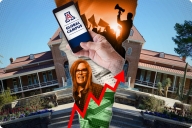You have /5 articles left.
Sign up for a free account or log in.
William Mitchell College of Law has received approval from the American Bar Association to launch a part-time J.D. program that blends face-to-face instruction with online courses. Although the hybrid program marks the first of its kind, experts are split on whether it marks an experiment or a turning point for how legal education is delivered in the U.S.
The four-year part-time program, meant for students whose location or work commitments prevent them for pursuing a legal education full-time, will mix recorded lectures and quizzes with video conferences and online discussion forums when it launches in January 2015. Students will also be required to complete externships and attend weeklong on-campus simulations at the end of each semester to practice their legal skills. Mitchell's Board of Trustees approved the program Tuesday night.
“Our message is that this is not an online J.D. degree,” said Eric S. Janus, president and dean of the college. “This is a J.D. degree that has very substantial and rigorous face-to-face components that I think are going to be designed in a unique way to help people become more prepared to practice law.”
Online education and accreditation from the American Bar Association rarely mix. Although fully online law programs exist without ABA approval, institutions that seek accreditation need to tailor their programs to a set of standards that have been in effect since 2002. The program itself needs to consist of at least 83 credits -- Mitchell’s hybrid program clears that hurdle exactly -- but no more than 12 can be granted from pure distance education. Of the remaining credits, one-third of the coursework can also be completed remotely. As an added twist, programs can offer only four credits of distance learning per semester.
Barry Currier, managing director of the ABA’s legal education section, said the four-credits-per-semester rule may have discouraged law schools from experimenting with hybrid programs. He also pointed out that few law schools seem to be aware of or interested in developing programs that take advantage of those regulations.
“Maybe they think their students won’t like it?” said Currier, previously dean of the online Concord Law School of Kaplan University, which after clashing with the ABA decided not to seek its approval. “Maybe they think employers won’t be interested in students that went to a school that was one-third blended?”
For many law schools, the requirements regulating distance education have been been viewed as “insurmountable,” said Simon Canick, associate dean of information resources at Mitchell. “I think a lot of law schools also use the existing ABA standards as a reason to not push the envelope,” he added.
To receive approval for its hybrid program, Mitchell submitted a variance request that exempts the program from the requirements -- under certain conditions. The college must enroll no more than 96 students per year, assess the program on an annual basis and report its findings to the ABA. The college also had to waive its right to confidentiality to help other law schools learn from its experiences.
“I see this as a first step for the ABA to be welcoming of innovation,” Janus said.
Variance requests represent another untapped opportunity for law schools to experiment with new forms of legal education, Currier said. “The ABA has not gone around and said ‘Oh please, please, please submit a variance request,’ ” he said. “It is not the case that there are dozens of requests for variances about distance learning that have been turned down. Maybe the perception is they would have been turned down.”
If the experiments prove successful, however, they could guide the ABA to revise its own standards, Currier said.
The approval of the hybrid J.D. program can also be seen as the ABA responding to those who have called for law school reform -- a group that includes President Obama, a graduate of Harvard Law School. The ABA last year launched a Task Force on the Future of Legal Education, which concluded the organization’s own policies was stymieing innovation.
“The current procedures under which schools can seek to vary from ABA Standards in order to pursue experiments are narrow and confidential,” the task force reported in September.
Mitchell submitted its variance request in July, and Canick said the college benefited from the timing of the task force’s report.
“I think the ABA faces some significant pressure externally to innovate and allow innovation,” Canick said. “Here comes this proposal that’s really good. I think they were eager to show they were going to embrace innovation.”
Mitchell, an independent law school located on one block in the residential Summit Hill neighborhood of St. Paul, Minn., may not seem like a hotbed of legal education reform. Like many law schools, the college has seen its enrollment shrink over the past few years. About 240 students enrolled this fall, down from about 260 the year before and about 300 two years ago.
“We’re doing fine, comparatively speaking,” Janus said. “I do think that part of the message is that law schools have to add value, and the programs they offer need to be meaningful and accessible to the people who want to study law. This is not a response to declining enrollment.”
The online option instead represents a third track and a nod to the college’s history, Janus said. Mitchell was founded in 1900 as St. Paul College of Law, a night school catering to the same type of students who would consider an online education. The college added a full-time option in the '70s.
Aside from the mode of delivery, the three tracks are fairly similar. Applicants for the hybrid program won’t see more lenient admissions requirements or tuition savings, for example. “We understand that the blended learning is not for everybody, but it will meet -- we think -- the needs of a group of people,” Janus said.
The law school has for years offered about a dozen blended and online courses, and plans for a fully hybrid J.D. program have been in the works since 2009. Currier said the the decision to approve the request was a result of the strength of Mitchell’s application, not external pressure.
“What the council saw was that this was a school that has a long history of part-time legal education and a long history of serving students who are a little more nontraditional in terms of age and working experience than many law schools,” Currier said. “I think it’s safe to say something like this has never been approved before.”








